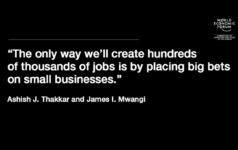Dalberg uses cookies and related technologies to improve the way the site functions. A cookie is a text file that is stored on your device. We use these text files for functionality such as to analyze our traffic or to personalize content. You can easily control how we use cookies on your device by adjusting the settings below, and you may also change those settings at any time by visiting our privacy policy page.
In Kenya, youth NEET – young people not in education, employment, or training – are among the most vulnerable, with few prospects for income-generating activities in the future.
Who are these youth, what are their challenges, enablers, and aspirations, and what would it take to increase their access to opportunities? These are the questions that serve as the basis for Dalberg’s report “Youth not in education, employment, and training in Kenya”, which launched on October 16, 2019 at the Kenya Institute of Curriculum Development.
The report stemmed from the belief that Kenya can harness its current demographic dividend and shift the balance of the labor market by bringing NEET youth into the fold. This can be done through a series of programs and collaborations, many of which involve increased collaboration between actors in government, educational institutions, and private firms.
To arrive at the recommendations, Dalberg examined Kenyan youth NEET’s core values and capabilities, including their attitudes and perceptions towards capabilities for work and life. We also took a look at their engagement with and interest in technical and vocational training institutes. In addition, we examined the perceived barriers and drivers towards achieving their career and life goals. In all, 2,361 youth were surveyed in 250 areas across Kenya, with quantitative survey research complemented by human-centred design (HCD) studies.

















